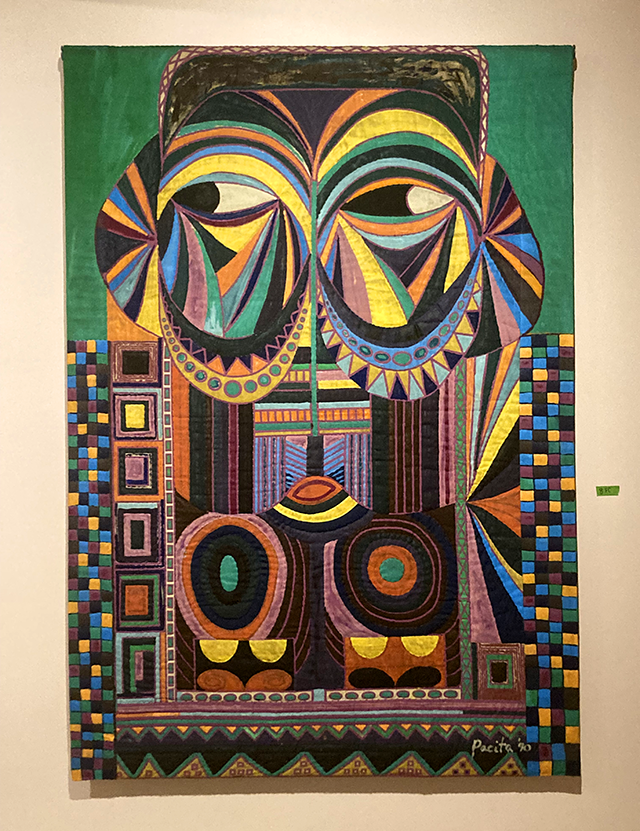A gallery room in the Walker Art Center’s retrospective exhibition of Pacita Abad’s 32-year career features works from Abad’s “Bacongo” series, named after a region in Central Africa that now makes up the Republic of Congo and the Dominican Republic. The paintings resemble bifwebe masks made by Songye and Luba ethnic groups. They are giant paintings, made on a quilted surface and stitched onto canvas. Each mask draws inspiration from different parts of the world, but according to Walker Curatorial fellow Matthew Villar Miranda, they have a subtle political point of view.
“The subserve thing is who she chooses to highlight and why,” Villar Miranda says. “The Hopi are not typically chosen to represent the North American continent. Mayan isn’t typically chosen to represent South America. She’s really inverted conceptions of global north, global south, and is representing indigeneity as central.”
Abad also made a European mask, though Europe is “not particularly known for their masking traditions,” Villar Miranda says, noting Abad’s comment on the work: “You generalize us. We generalize you.”
Abad created the mask works using her signature trapunto technique, a process that involved stitching fabric onto canvas and embellishing the surface with hand-made fabrics, buttons, shells, and other adornments.
“It was a technique that she learned from a friend and then innovated on,” says Victoria Sung, the Walker’s associate curator of visual arts, who curated the exhibition. “She would paint her canvases either using acrylic or oil, and instead of stretching that canvas over a frame as you normally might, she would then add layers of backing and padding and stuffing and then stitch it all by hand.”
Much of Abad’s career was spent traveling across six continents alongside her husband, Jack Garrity, an international development economist. The two had met at a world affairs conference in Monterey, California, when they were both students representing their schools. After meeting, they spent a year traveling to different art scenes across Asia. Throughout their time together, they’d spend time in Sudan, Bangladesh, Egypt, the Dominican Republic, and many more places.

At first, Garrity said Abad would work with canvas on an easel. But because they were traveling so much, that method became cumbersome. “We got into a huge fight over one because I had to carry it and roll it up.” Later, Abad began to paint on the floor, or by stapling canvases on a wall. After she was finished, she’d roll them up, an idea from a Tibetan refugee camp in Nepal, called Thangka. The works could be rolled up like quilts and carried away, making them much more portable than canvas stretched across a frame.
Abad’s trapunto process was laborious, and informed by the many places Abad would visit. “She actually lived and worked and traveled over 60 countries in her lifetime,” Sung says. “In all of these geographies, she picked up different materials, different techniques and incorporate them into her making. So they’re really kind of amazing, cornucopias of a global pluralism.”
Besides Abad’s trapunto paintings, the exhibition at the Walker — organized by the museum with Abad’s estate — features works on paper, costumes, and ceramic works. There are paintings made on clothing she “borrowed” from her husband, Jack, large scale paintings that share narratives of immigrant communities, particularly women of color, and often political works that are political in whose stories she is highlighting (i.e. communities often not often represented in mainstream narratives). Abad’s “L.A. Liberty” trapunto painting, featuring an immigrant woman as the Statue of Liberty, is a powerful depiction this centering of immigrant women in the iconic symbol of America.

Perhaps unsurprisingly, Abad’s work was often diminished because of both racism and sexism. One critic wrote more about Abad’s fashion choices than her art works in a 1986 review following Abad’s exhibition of “Underwater Wilderness” at the Ayala Museum in the Philippines. “Pacita Abad is a woman whose art may be primitive and rough but it is the strength of her personality, this ‘wild’ bohemian lifestyle which captures the imagination,” the review said.
That kind of minimizing of a woman of color’s abilities bares resemblance to another artist: Frida Kahlo, whose personality and life story have been endlessly commodified by popular culture in an infantilizing way.
In her essay in the catalogue that accompanies the exhibition, Sung notes that Abad’s work was rarely contextualized alongside peers tackling similar topics— including Hawardena Pindell, Carlos Villa, and Jimmie Durham, whose retrospective in 2017, also at the Walker, drew controversy due to Durham’s Cherokee identity claims..
The Walker’s retrospective is an attempt to rectify that error of history by showing over 100 objects— many never seen before in the United States— of Abad’s contributions, and by also creating an extensive catalogue of Abad’s work. It takes Abad seriously as an artist, even as it celebrates the artist’s exuberance, joy of color, culture, people, and creativity.
“Pacita Abad” runs through Sept. 3 at the Walker Art Center ($18). More information here.


0 Commentaires